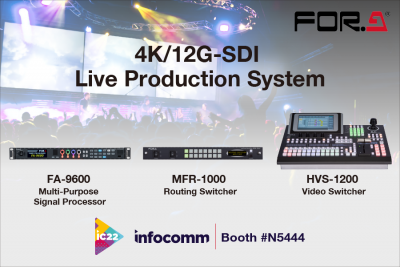Ask the experts - Fibre optic distribution and content delivery

Author: Bob Pank#
Published 1st May 2012
1- With the increase in bandwidth requirements for signal distribution systems, which infrastructure provides greater benefits — copper or fibre? Can you explain why?
Both copper and fibre each have their place in today’s broadcast infrastructure. As we know, the useable bandwidth of coax cable is a function of both its physical construction and the length of the cable between the source and load. Modern IC line drivers and equalizers offer some ability to compensate for distortions associated with long lengths of coax to make them useable in more applications. But there are limits and costs associated with these techniques, and when taken together with the physical size and cost of the coax, their economic impact must be carefully considered in the overall system design. Clearly, for relatively short lengths, coax cable offers a straightforward choice for single channel signal distribution. But today’s modern facilities, with changing and varied signal formats, require a more flexible and economic cable infrastructure.
Fibre cable has many technical and economic advantages compared to the coax cable needed for today’s high definition video transport. Physically, it is thinner and lighter. Even when each glass “core” is individually jacketed, it is only a fraction of the size and weight of HD coax for a given length. Keep in mind that fibre carries no electrical current nor does it contain any metallic contact. These characteristics allow it to be installed in a variety of facilities that would otherwise be considered off limits for copper cabling, such as ones that are adjacent to AC power lines, fluorescent ballasts and motors. Single mode fibre can also transport multiple signals, and in a bi-directional manner, on one core.
2- We keep hearing that fibre optic systems are difficult to install and maintain. Can you comment on that?
Years ago the reliable termination of a fibre connector onto the end of fibre was a black art. It required patience, skill and a high tolerance for failure. I’m happy to report that all that has changed for the better. Today, several manufacturers have developed pre-terminated crimp type fibre optic connectors in many different styles supporting both single mode and multimode fibre types. If you can terminate a BNC connector onto coax you have the skills to terminate a fibre connector in a matter of minutes. Termination kits are not expensive and consist of a collection of hand tools, a cleaver and stripper.
Additionally, there are also low cost, simple to use optical power meters and light sources to facilitate the installation, maintenance and troubleshooting of fibre installations. Once you understand the basic concepts of link budgets and wavelengths, and you have a practical understanding of optical connections, maintaining a fibre installation is really straightforward. One tip: When in doubt, clean the connector tips. It’s amazing how just this one simple maintenance action can eliminate the majority of fibre system problems.
Just use the same diagnostic skills you have developed in your experience with copper based systems, such as substitution of components and paths that are suspect. The same techniques also apply to fibre. Over time, you an increase the array of diagnostic equipment in your tool kit to make installation and maintenance more efficient.
3- Which applications are most ideal for fibre optic technologies? For copper?
There is no specific guideline to say when copper or fibre should be used. Certainly, when the transmission length is beyond the capability of coax cable, even with equalization, then fibre is the ideal solution. However, in all these considerations of copper versus fibre, the number and complexity of the array of signals to be distributed, along with the distribution topology, needs to be taken into account. Too often designers think of fibre as only a long distance solution to be used when copper cable no longer works effectively. While this is one decision point for fibre deployment, it doesn’t take into account the technical and economic characteristics unique to fibre that make it the right choice for many more applications.
Consider the case where multiple HD-SDI signals need to be transported from point A to point B over a distance of 250 meters. The copper solution would be to have an HD grade coaxial cable for each HD-SDI signal. The resulting bundle would be quite thick, heavy and inflexible. Yet, no interfaces would be required at the source and load. However, with one core of single mode fiber we could easily multiplex all of these HD-SDI signals and have a very small (< 3mm) cable that is very low cost, easy to install and lightweight. Yes, the proper optical multiplexing equipment is required, but this total system cost must be compared to the alternative total cost for a copper solution. As system requirements become more complex, you’ll find the tradeoff between copper and fiber will be less about distance and more about cost and performance.
4- What are the main differences between single mode fiber and multimode fiber? How do you know which one is right for your facility?
Bandwidth, bandwidth, bandwidth!
Decades ago when fibre cable was first manufactured, it was difficult to create fibre cable thin enough to contain the light travelling through it without a lot of dispersion, that is the scattering of the light beams (or “modes”) as the light travelled through the fiber. This dispersion caused a fair amount of attenuation and distortion of the light over the transmission distance and a great deal of scattering of the light. Think of the light emanating from the headlight of a car and the resulting light that is cast 30 meters down the road.
Over time, single mode fibre became available with a core size that was only 1/10th the core size of multimode fibre. This allowed laser sources to be used with a very coherent single mode of light and resulted with light being transported over the fibre with very low attenuation and dispersion. As a result, an extremely large amount of information could be transported over great distances creating a medium with virtually infinite bandwidth over distances commonplace in the broadcast environment.
For this reason the broadcast community will invariably use single mode fibre when given the choice. Ironically, the single mode fibre is actually less expensive then multimode fiber types. So, why would multimode fiber be used at all given a choice? Mainly due to influences from the IT community that do not have the same signal integrity issues that are in broadcast signals and have more stringent cost considerations for the interface devices between their IT equipment and the fibre.
5- What advice can you offer broadcasters and video professionals who want to make the switch from copper to fiber in their facility?
Think about fibre from the very start of the project design. Design with a clean sheet of paper to take advantage of the unique characteristics and products that fibre has compared to copper. Too many times a designer will create a copper based system and then use fibre here and there simply to substitute for the long cable runs that are too great for copper. This is shortsighted and fails to take advantage of fibre for bandwidth, aggregation of baseband signals, low signal distortion and point to multipoint distribution.
Keep in mind future system expansion too. The cable infrastructure you install will probably be needed for many years into the future. While copper might be adequate for today’s signal needs, will it be adequate for what this industry has in mind for the future? The cost of a cable infrastructure and its installation can be a major expense component of any project. You want to be able to leverage that investment far into the future.
The second thing I would offer is to start small with fibre. If you are new to fibre you undoubtedly have some concerns and little, if any, experience. That’s OK, we all have to start somewhere. So, install a simple point-to-point link for SDI and run a non-critical signal through it. See how it holds over time and under various operating conditions. Compare it to coax for economy and performance. Over time you’ll get confidence and the experience to expand to larger and more complex installations.
6- What new products are you highlighting at your booth this year? Can you tell me about their key features?
We continue to create products under our Fiberlink® brand that aggregates the transmission of multiple baseband signals over one fibre with just one product. This is the best way to offer value to the customer and exploit the unique properties of fibre technology.
Our Fiberlink 8200 ODA (Optical Distribution Amplifier) is unique in the industry for optical distributing 3G/HD/SD-SDI over fibre from either a copper of fibre input. The ODA has up to four (4) independently buffered and laser driven outputs. Both single mode and multimode fibre is supported and the units may be looped or cascaded to create a wide array of point-to-multipoint distribution topologies.
The Fiberlink 3380 Series embeds 4 channels of analog audio into a 3G/HD/SD-SDI signal, then transports it over fibre. The Fiberlink 3381 does the de-embedding from the fibre optic input. The product is fully SMPTE compliant. These are the perfect compliments to our 3360 Series for embedding and de-embedding AES/EBU audio in a fibre optic system.
The Fiberlink 3370 is a perfect example of how several different baseband signals can be aggregated into to one box and transported over one inexpensive fibre core. In this product, 3G/HD/SD-SDI, 10/100 Base-T Ethernet and two RS data channels are transparently transmitted without any compression. It’s perfect for PTZ SDI cameras.
Our new Copperlink™ product line will have two new additions. The 2380 is a standalone 4-channel analog audio embedder and the 2381 is a 4-channel analog audio de-embedder. Both support 3G/HD/SD-SDI signals and user selectable Group assignment.
About:
The NY-based Communications Specialties, Inc. (CSI) is the manufacturer of a variety of products for the distribution, conversion or transmission of television and computer video signals, including fiber optic transmission systems, scan converters and video scalers. The company’s widely used Fiberlink line includes the venerable 3350-Series, which was one of the first fiber optic links to transmit 3G-SDI over one single mode or multimode fiber in the same unit. Since then, numerous Fiberlink products have been introduced, with several new additions on display at NAB 2012. The Fiberlink family provides support for nearly every signal format being used in professional video today. In 2011, CSI launched Copperlink, a series of copper based 3G/HD/SD-SDI distribution and conversion products that directly complement their Fiberlink counterparts. The line was launched with the introduction of the 2302 1x2 3G/HD/SD-SDI distribution amplifier, the 2304 1x4 3G/HD/SD-SDI distribution amplifier and the 2353 3G/HD/SD-SDI to HDMI converter.
More information on Communications Specialties can be found at: www.commspecial.com


























